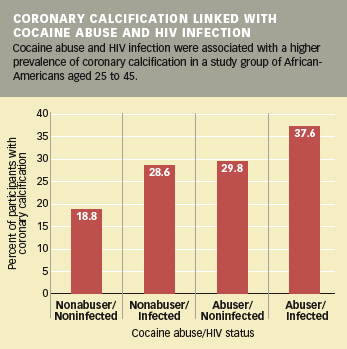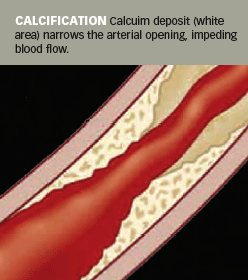Cocaine abuse and HIV infection each raise the likelihood that calcium deposits will form in coronary arteries, according to a NIDA-supported study. The findings, by Dr. Shenghan Lai and colleagues at The Johns Hopkins University, suggest that individuals with either problem may develop elevated risks for serious, potentially fatal heart disease. The gradual buildup of calcium deposits and fat along the inner walls of blood vessels produces atherosclerosis, the narrowing and obstruction of the vessels that is a major cause of strokes and heart attacks. Although none of the participants in the study had a clinical heart problem, all were relatively young to have coronary calcification.
Dr. Lai and his colleagues used cardiac computed tomography (CT) scanning to detect the presence of coronary calcification and the number, size, and volume of calcium deposits in 192 African-American men and women aged 25 to 45. Thirty-two of the participants did not have HIV infection and had never abused cocaine (HIV-/cocaine-), 28 had the infection and were nonabusers (HIV+/cocaine-), 47 did not have the infection and had abused cocaine (HIV-/cocaine+), and 85 had both conditions (HIV+/cocaine+). About two-thirds were men.
The results revealed coronary calcification in almost one-third (31 percent) of the participants. The prevalence was twice as high in the HIV+/cocaine+ group (38 percent) as in the HIV-/cocaine- group (19 percent). In the other two groups, the proportion of participants with the condition fell in between, with 29 percent of the HIV+/cocaine- and 30 percent of the HIV-/cocaine+ groups showing coronary calcification (see chart). In the U.S. population as a whole, the prevalence of coronary calcification among 25- to 45-year-olds is about 18 percent.

Participants with HIV infection and/or a history of cocaine abuse had more calcium deposits and a greater volume of calcification than nonabusers without the infection. Compared with the HIV-/cocaine- group, the total volume of coronary calcium was 2.9 times as high in the HIV+/cocaine- group, 2.6 times as high in the HIV-/cocaine+ group, and 3.5 times as high in the HIV+/cocaine+ group. The associations held when the researchers took into account cardiovascular disease risk factors, including age, body mass index, lipid levels, blood pressure, and whether patients were taking HIV medication. The study was too small to determine whether HIV and cocaine contribute independently to calcification when both are present, or whether they interact physiologically to promote it even more.

Cardiovascular complications have been well documented in patients who abuse cocaine and also have HIV infection, but this study is the first to show arterial changes prior to the development of cardiovascular symptoms and to link them with cocaine abuse alone and HIV infection alone. Larger, longer studies are needed to confirm Dr. Lai's associations and to determine whether or how cocaine- and HIV-associated calcification progresses to clinical atherosclerosis and heart disease.
Dr. Jag Khalsa of NIDA's Division of Pharmacotherapies and Medical Consequences of Drug Abuse says early signs of cardiovascular disease should be taken very seriously because they are strongly connected to two major causes of death—stroke and heart attacks. "Coronary calcification among people at such a young age is a striking observation and suggests that clinicians should monitor heart disease in these populations, advise patients to make lifestyle changes, and perhaps treat conditions that affect heart health, such as high blood pressure," says Dr. Khalsa.
Source
- Lai, S., et al. Human immunodeficiency virus 1 infection, cocaine, and coronary calcification. Archives of Internal Medicine 165(6):690-695, 2005. [Abstract]
